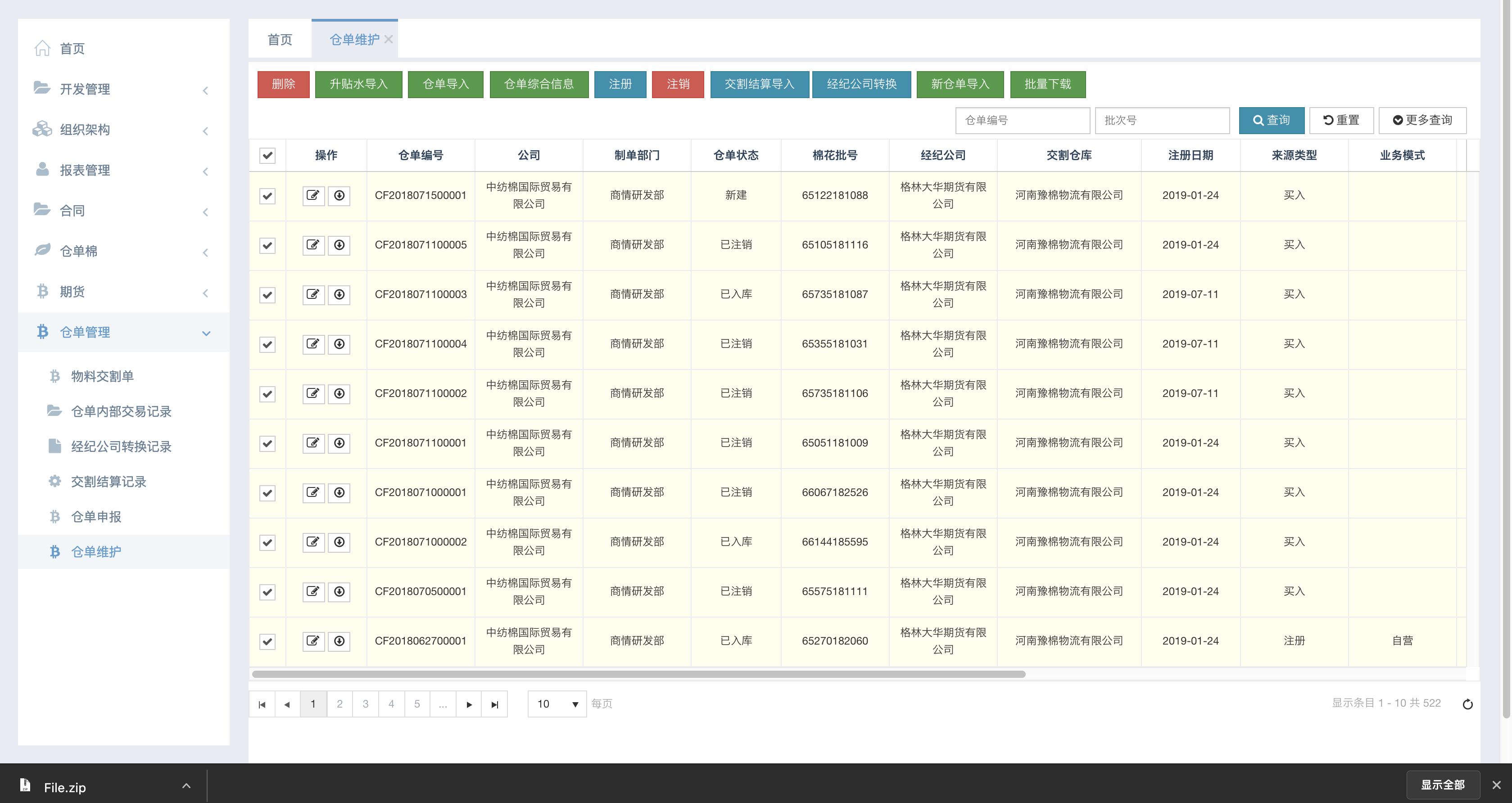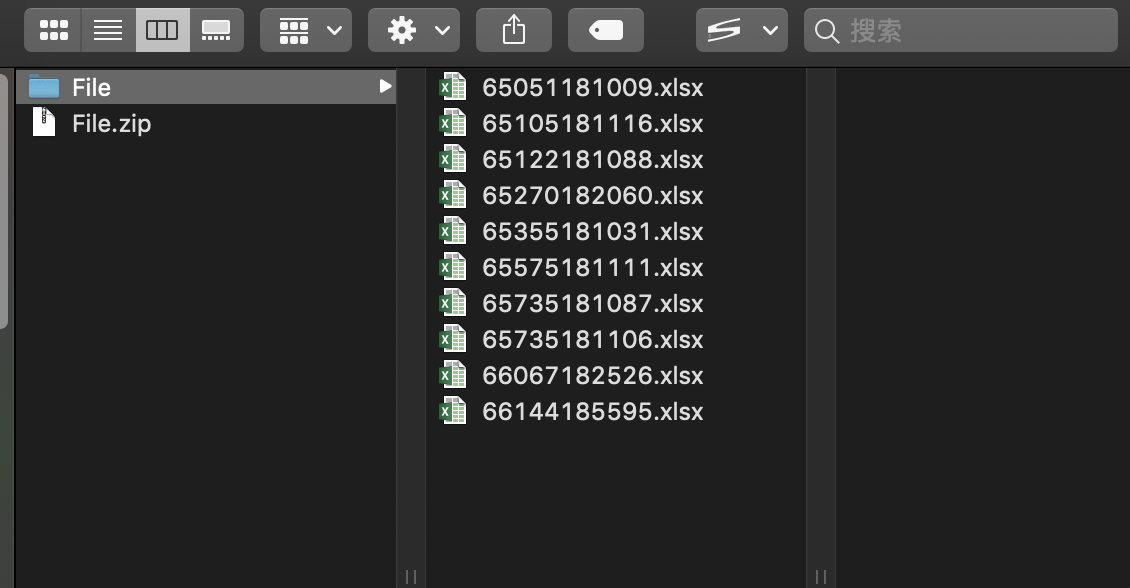本篇功能是基于Fastdfs文件上传下载功能,作出的将文件打包成一个zip文件下载下来。
页面效果如下

选择行,点击批量下载按钮,然后就会将所有的文件打包成一个File.zip文件下载下来。解压zip文件夹,就能看到里面包含了下载的所有文件。这种下载方式不局限于xlsx文件,图片格式,文本格式,Java文件等都可以使用这种方式下载下来。

前台代码
//批量下载function downloadFunction() {var selected = grid.selectedDataItems();if(selected.length>0) {kendo.ui.showConfirmDialog({title: "提示",message: "确定要下载?"}).done(function(event) {if (event.button == "OK") {var recpIdList = new Array();$.each(selected,function(i,v){recpIdList.push(v.recpId);});debugger;window.location.href="${base.contextPath}/ect/fut/receipt/batchDownload?recpIdList="+recpIdList;}});}else{kendo.ui.showWarningDialog({message:"请至少选择一行"})}}
上述是批量下载功能函数,第一步是获取所有行,如果没有选择行,将弹出警告框“请至少选择一行”,第二步,根据所选行去查询文件的服务器路径以及文件名,假如路径都为空,则下载一个空的zip文件,不为空,则将文件打包成zip格式下载。
后台代码
List<ZipModel> zipModelList = new ArrayList<>();for (Long recpId : recpIds) {FutReceipt futReceipt = new FutReceipt();futReceipt.setRecpId(recpId.floatValue());futReceipt = futReceiptMapper.selectByPrimaryKey(futReceipt);//todo:仓单表主键不能为空并且文件不能为空if (futReceipt.getRecpId() != null && futReceiptMapper.getFilePathById(futReceipt.getRecpId()) != null) {try {ZipModel zipModel = new ZipModel();String filePatch = getFilePatch(futReceipt, requestContext);//todo:存储文件路径zipModel.setFilePath(filePatch);//todo:获取文件后缀,并且将仓单批次作为文件名zipModel.setFileName(futReceipt.getBatchNum() + filePatch.substring(filePatch.indexOf(".") + 1));zipModelList.add(zipModel);} catch (Exception e) {e.printStackTrace();}}}//todo:设置打包后的文件名String fileName = "File.zip";//todo:临时文件目录,用于存储打包的下载文件String globalUploadPath = request.getSession().getServletContext().getRealPath("/");String outFilePath = globalUploadPath + File.separator + fileName;File file = new File(outFilePath);//文件输出流FileOutputStream outStream = new FileOutputStream(file);//压缩流ZipOutputStream toClient = new ZipOutputStream(outStream);//todo:调用通用方法下载fastfds文件,打包成zip文件ZipUtil.zipFile(zipModelList, toClient);toClient.close();outStream.close();response.setHeader("content-disposition", "attachment;fileName=" + fileName);//todo:将zip文件下载下来ZipUtil.downloadZip(file, response);
实现步骤主要是将所有的fastdfs的文件路径和文件名存储到一个zipModelList对象中。然后先调用通用方法zipFile将这些文件下载下来打包成一个zip文件,放在一个临时存储位置,最后再通过通用方法downloadZip将文件下载下来。
存储数据对象
ZipModel.Java
public class ZipModel {/*** 文件名*/private String fileName;/*** 文件在fastdfs文件服务器路径*/private String filePath;public String getFileName() {return fileName;}public void setFileName(String fileName) {this.fileName = fileName;}public String getFilePath() {return filePath;}public void setFilePath(String filePath) {this.filePath = filePath;}}
通用生成下载zip方法
ZipUtil.Java
public class ZipUtil {private static String IFastdfsService = "hfastdfs.fastdfsfile.service.IFastdfsService";/*** 压缩文件列表中的文件** @param files* @param outputStream* @throws IOException* @throws ServletException*/public static void zipFile(List<ZipModel> files, ZipOutputStream outputStream) throws IOException {try {int size = files.size();//压缩列表中的文件for (int i = 0; i < size; i++) {ZipModel zipModel = files.get(i);try {zipFile(zipModel, outputStream);} catch (Exception e) {continue;}}} catch (Exception e) {throw e;}}/*** 将文件写入到zip文件中** @param zipModel* @param outputstream* @throws IOException* @throws ServletException*/public static void zipFile(ZipModel zipModel, ZipOutputStream outputstream) throws AppException, IOException, MyException {try {if (zipModel != null && zipModel.getFilePath() != null && zipModel.getFileName() != null) {IFastdfsService iFastdfsService = (IFastdfsService) getBean(IFastdfsService);InputStream bInStream = new ByteArrayInputStream(iFastdfsService.getFile(zipModel.getFilePath()));ZipEntry entry = new ZipEntry(zipModel.getFileName());outputstream.putNextEntry(entry);final int MAX_BYTE = 10 * 1024 * 1024; //最大的流为10Mlong streamTotal = 0; //接受流的容量int streamNum = 0; //流需要分开的数量int leaveByte = 0; //文件剩下的字符数byte[] inOutbyte; //byte数组接受文件的数据streamTotal = bInStream.available(); //通过available方法取得流的最大字符数streamNum = (int) Math.floor(streamTotal / MAX_BYTE); //取得流文件需要分开的数量leaveByte = (int) streamTotal % MAX_BYTE; //分开文件之后,剩余的数量if (streamNum > 0) {for (int j = 0; j < streamNum; ++j) {inOutbyte = new byte[MAX_BYTE];//读入流,保存在byte数组bInStream.read(inOutbyte, 0, MAX_BYTE);outputstream.write(inOutbyte, 0, MAX_BYTE); //写出流}}//写出剩下的流数据inOutbyte = new byte[leaveByte];bInStream.read(inOutbyte, 0, leaveByte);outputstream.write(inOutbyte);outputstream.closeEntry();bInStream.close(); //关闭}} catch (IOException e) {throw e;}}/*** 下载打包的文件** @param file* @param response*/public static void downloadZip(File file, HttpServletResponse response) {try {if (!file.exists()) {file.createNewFile();}// 以流的形式下载文件。BufferedInputStream fis = new BufferedInputStream(new FileInputStream(file.getPath()));byte[] buffer = new byte[fis.available()];fis.read(buffer);fis.close();// 清空responseresponse.reset();OutputStream toClient = new BufferedOutputStream(response.getOutputStream());response.setContentType("application/octet-stream");response.setHeader("Content-Disposition", "attachment;filename=" + file.getName());toClient.write(buffer);toClient.flush();toClient.close();file.delete(); //将生成的服务器端文件删除} catch (IOException ex) {ex.printStackTrace();}}/*** 获得bean,通过ApplicationContext获取** @return*/public static Object getBean(String className) {HttpServletRequest request = ((ServletRequestAttributes) RequestContextHolder.getRequestAttributes()).getRequest();ServletContext sc = request.getSession().getServletContext();ApplicationContext ac = WebApplicationContextUtils.getRequiredWebApplicationContext(sc);Class c;try {c = Class.forName(className);return ac.getBean(c);} catch (ClassNotFoundException e) {// TODO Auto-generated catch blocke.printStackTrace();}return null;}}
以上就是fastdfs文件下载的全部方法

